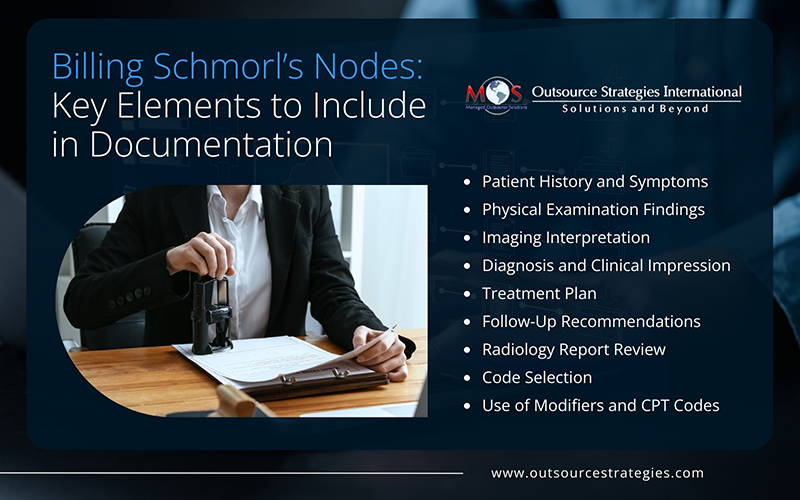Schmorl’s nodes, also known as intravertebral disc herniations, are protrusions of the cartilage of the intervertebral disc into the vertebral body. Often asymptomatic, the nodes are often detected incidentally during imaging studies. Their presence can be clinically significant – especially when they cause chronic back pain, spinal instability, and other complications.
For chiropractors, spine specialists and physical therapists treating the condition, accurate Schmorl’s nodes billing is critical for ensuring proper reimbursement and maintaining compliance with insurer requirements. This guide outlines the medical billing process for Schmorl’s nodes diagnosis, including proper interpretation of radiology report terminology and ICD-10 coding for the condition.
Partnering with a medical coding company can ensure proper code assignment, organize documentation, and help healthcare providers stay compliant with payer regulations.
Interpreting Schmorl’s Node Radiology Report Terminology
The first step for appropriate coding is to understand how Schmorl’s nodes are described in radiology reports. Common terms include – endplate irregularities, disc protrusion into the vertebral body, intraosseous herniation and vertebral body lesion. A radiology report may not always use the exact term “Schmorl’s node,” so it’s essential to be familiar with synonymous terminology to ensure accurate coding. Healthcare providers must correlate radiologic findings with clinical symptoms to justify treatment and billing.
Need help with chiropractic medical billing?
To streamline your billing for Schmorl’s nodes and other spinal conditions.
ICD-10 Codes for Schmorl’s Nodes Billing
The ICD-10 coding guidelines for Schmorl’s nodes billing, healthcare providers must use specific codes based on the patient’s symptoms and imaging results. Commonly used ICD-10 codes include:
- M51.4 Schmorl’s nodes
- M51.44 …… thoracic region
- M51.45 …… thoracolumbar region
- M51.46 …… lumbar region
- M51.47 …… lumbosacral region
When coding for Schmorl’s nodes, it is essential to document the exact anatomic location associated symptoms, such as pain or inflammation and severity of the condition. If the Schmorl’s node is related to trauma or a degenerative disorder, additional codes may be needed to reflect the full clinical picture. Additional codes include:
- M51.8 Other thoracic, thoracolumbar and lumbosacral intervertebral disc disorders
- M51.84 Other intervertebral disc disorders, thoracic region
- M51.85 Other intervertebral disc disorders, thoracolumbar region
- M51.86 Other intervertebral disc disorders, lumbar region
- M51.87 Other intervertebral disc disorders, lumbosacral region
- M51.9 Unspecified thoracic, thoracolumbar and lumbosacral intervertebral disc disorder
- M51.A Other lumbar and lumbosacral annulus fibrosus disc defects
- M51.A0 Intervertebral annulus fibrosus defect, lumbar region, unspecified size
- M51.A1 Intervertebral annulus fibrosus defect, small, lumbar region
- M51.A2 Intervertebral annulus fibrosus defect, large, lumbar region
- M51.A3 Intervertebral annulus fibrosus defect, lumbosacral region, unspecified size
- M51.A4 Intervertebral annulus fibrosus defect, small, lumbosacral region
- M51.A5 Intervertebral annulus fibrosus defect, large, lumbosacral region
Key Elements to Include in Documentation
- Patient History and Symptoms: Clearly outline the patient’s presenting symptom (e.g., back pain, stiffness, limited mobility) and the duration, severity, and any exacerbating factors.
- Physical Examination Findings: Include spinal range of motion, palpation results, neurologic findings, and any observed functional impairments.
- Imaging Interpretation: Quote or summarize relevant sections from the radiology report that reference Schmorl’s nodes. Use the same or closely related terminology to maintain consistency.
- Diagnosis and Clinical Impression: Specify whether the Schmorl’s nodes are incidental or potentially contributory to the patient’s symptoms. If they are significant to the treatment plan, this should be clearly noted. Include physical exam results and correlate them with radiologic evidence.
- Treatment Plan: Outline the management approach, including chiropractic adjustments, physical therapy, medications, or referrals. Indicate how the presence of Schmorl’s nodes informs or modifies the treatment strategy.
- Follow-Up Recommendations: Include monitoring, additional imaging, or reassessment timelines, particularly if the Schmorl’s node is suspected to be symptomatic or progressing.
- Radiology Report Review: Carefully interpret the radiology report and note any mention of Schmorl’s nodes or related findings. Be attentive to Schmorl’s node radiology report terminology that might not be explicit.
- Code Selection: Use the most appropriate ICD-10 codes based on clinical findings and imaging. If treatment is directed specifically at Schmorl’s nodes (e.g., spinal adjustment, physical therapy), ensure this is clearly documented.
- Use of Modifiers and CPT Codes: Pair ICD-10 codes with relevant CPT codes for procedures (e.g., spinal manipulation). Modifiers may be necessary if multiple procedures are performed or if the services are repeated.

Correct billing and coding for Schmorl’s nodes is a complex process that requires understanding radiologic terminology, adhering to ICD-10 coding guidelines, and following a well-structured medical billing process. Medical billing for chiropractors and spine specialists involves unique challenges. Partnering with experts in the field can ensure accurate coding and reimbursement, optimizing both patient outcomes and practice revenue.
Have questions about billing Schmorl’s nodes?




